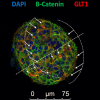The activation of dormant ependymal cells following spinal cord injury
- PMID: 37408068
- PMCID: PMC10324230
- DOI: 10.1186/s13287-023-03395-4
The activation of dormant ependymal cells following spinal cord injury
Abstract
Ependymal cells, a dormant population of ciliated progenitors found within the central canal of the spinal cord, undergo significant alterations after spinal cord injury (SCI). Understanding the molecular events that induce ependymal cell activation after SCI represents the first step toward controlling the response of the endogenous regenerative machinery in damaged tissues. This response involves the activation of specific signaling pathways in the spinal cord that promotes self-renewal, proliferation, and differentiation. We review our current understanding of the signaling pathways and molecular events that mediate the SCI-induced activation of ependymal cells by focusing on the roles of some cell adhesion molecules, cellular membrane receptors, ion channels (and their crosstalk), and transcription factors. An orchestrated response regulating the expression of receptors and ion channels fine-tunes and coordinates the activation of ependymal cells after SCI or cell transplantation. Understanding the major players in the activation of ependymal cells may help us to understand whether these cells represent a critical source of cells contributing to cellular replacement and tissue regeneration after SCI. A more complete understanding of the role and function of individual signaling pathways in endogenous spinal cord progenitors may foster the development of novel targeted therapies to induce the regeneration of the injured spinal cord.
Keywords: Activation; Ependymal cells; Regeneration; Spinal cord injury.
© 2023. The Author(s).
Conflict of interest statement
The authors declare no competing interests.
Figures


Similar articles
-
Connexin 50 Expression in Ependymal Stem Progenitor Cells after Spinal Cord Injury Activation.Int J Mol Sci. 2015 Nov 6;16(11):26608-18. doi: 10.3390/ijms161125981. Int J Mol Sci. 2015. PMID: 26561800 Free PMC article.
-
FM19G11 favors spinal cord injury regeneration and stem cell self-renewal by mitochondrial uncoupling and glucose metabolism induction.Stem Cells. 2012 Oct;30(10):2221-33. doi: 10.1002/stem.1189. Stem Cells. 2012. PMID: 22865656
-
Regenerative Potential of Ependymal Cells for Spinal Cord Injuries Over Time.EBioMedicine. 2016 Nov;13:55-65. doi: 10.1016/j.ebiom.2016.10.035. Epub 2016 Oct 28. EBioMedicine. 2016. PMID: 27818039 Free PMC article.
-
Ependymal cells in the spinal cord as neuronal progenitors.Curr Opin Pharmacol. 2020 Feb;50:82-87. doi: 10.1016/j.coph.2019.11.008. Epub 2019 Dec 31. Curr Opin Pharmacol. 2020. PMID: 31901616 Review.
-
The Spinal Ependymal Layer in Health and Disease.Vet Pathol. 2016 Jul;53(4):746-53. doi: 10.1177/0300985815618438. Epub 2016 Jan 20. Vet Pathol. 2016. PMID: 26792842 Review.
Cited by
-
Ependymal cells: roles in central nervous system infections and therapeutic application.J Neuroinflammation. 2024 Oct 9;21(1):255. doi: 10.1186/s12974-024-03240-2. J Neuroinflammation. 2024. PMID: 39385253 Free PMC article. Review.
-
Neurons derived from NeuroD1-expressing astrocytes transition through transit-amplifying intermediates but lack functional maturity.Sci Adv. 2025 Jul 25;11(30):eadw9296. doi: 10.1126/sciadv.adw9296. Epub 2025 Jul 25. Sci Adv. 2025. PMID: 40712017 Free PMC article.
-
Bridging the gap: a translational perspective in spinal cord injury.Exp Biol Med (Maywood). 2024 Sep 26;249:10266. doi: 10.3389/ebm.2024.10266. eCollection 2024. Exp Biol Med (Maywood). 2024. PMID: 39391076 Free PMC article. Review.
-
Spatial multi-omics analysis of the microenvironment in traumatic spinal cord injury: a narrative review.Front Immunol. 2024 Aug 29;15:1432841. doi: 10.3389/fimmu.2024.1432841. eCollection 2024. Front Immunol. 2024. PMID: 39267742 Free PMC article. Review.
-
Improving Efficiency of Direct Pro-Neural Reprogramming: Much-Needed Aid for Neuroregeneration in Spinal Cord Injury.Cells. 2023 Oct 20;12(20):2499. doi: 10.3390/cells12202499. Cells. 2023. PMID: 37887343 Free PMC article. Review.
References
Publication types
MeSH terms
Substances
LinkOut - more resources
Full Text Sources
Medical

